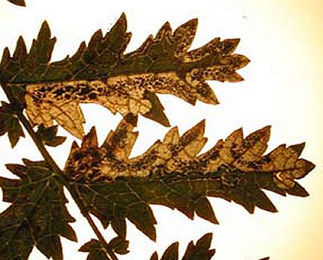|
||||||
|
Stigmella
filipendulae (Wocke, 1871) Dropwort Pigmy Nepticula
filipendulae Wocke, 1871
.
Cat. Lep. Eur.: 338 |
|||||||||||||||||||||||||||||||||||||||||||||||||||
Leaf-miner: The first part of the mine is almost filled with frass and tends to follow the leaf margin. It then broadens into a blotch, which can fill the space between the the midrib and leaf edge (British leafminers). Egg at the uppserside of the leaf, generally on a vein or the margin. The mine is a gradually widening corridor. The first, narrow, part closely follows the leaf margin. Frass in central, interrupted line, gradually widening from a very narrow beginning (Bladmineerders van Europa).
Larva: The larvae of moths have a head capsule and chewing mouthparts with opposable mandibles (see video of a gracillarid larva feeding), six thoracic legs and abdominal legs (see examples). Bright amber yellow (Emmer, 1983a); see Gustafsson and van Nieukerken (1990a) for a detailed description (Bladmineerders van Europa). Pupa: The pupae of moths have visible head appendages, wings and legs which lie in sheaths (see examples). Adult: The adult is not illustrated in UKMoths (check for update). The species is included in mothdissection.co.uk. Hosts in Great Britain and Ireland:
Hosts elsewhere:
Time of year - larvae: July, late August - October (British leafminers). Time of year - adults: Currently unknown. Distribution in Great Britain and Ireland: Britain including North Hampshire, North Somerset and South Wiltshire (NBN Atlas). See also British leafminers distribution map. Also recorded in the Republic of Ireland (Fauna Europaea). Distribution elsewhere: Widespread in continental Europe including Austria, Czech Republic, Danish mainland, Estonia, Finland, Germany, Greek mainland, Hungary, Poland, Slovakia and Sweden (Fauna Europaea). NBN Atlas links to known host species:
British and Irish Parasitoids in Britain and elsewhere:
|
|||||||||||||||||||||||||||||||||||||||||||||||||||
|
|
|
| External links: | Search the internet: |
|
Belgian Lepidoptera Biodiversity Heritage Library Bladmineerders van Europa British leafminers Encyclopedia of Life Fauna Europaea NBN Atlas NHM UK Checklist UKMoths |
Find
using Google Find using Google Scholar Find images using Google |
| Last updated 12-Jul-2019 Brian Pitkin | ||

